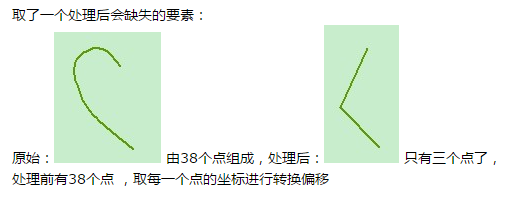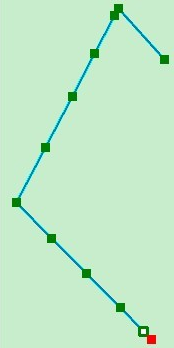参考资料:
1. 关于坐标转换计算: 在另一篇文章中有参考资料 http://www.cnblogs.com/beautifulplanet/p/4309222.html
2. 如何用arcpy进行处理呢,先找到这个链接
http://gis.stackexchange.com/questions/17096/edit-end-points-in-polyline-python-arcmap10,
从def offsetFirstPointInLine(line_geom,X_distance,Y_distance)函数中找到如何提取每一条线记录的每个点坐标:
geom = r.getValue("SHAPE") array = geom.getPart(0)
那array 是什么呢?
3. 上面那个例子只处理了每条线的一个点,而我需要对每个点进行处理,那怎么构成其中的new line呢?又去找ArcGIS的帮助,找到PolyLine类
http://help.arcgis.com/zh-cn/arcgisdesktop/10.0/help/index.html#/na/000v000000n2000000/
看看其中polyline是如何由点组装起来的。
解决方案:
经过上面三步梳理,整理代码如下
>>> import arcpy,math ... pi = 3.14159265358979324 ... a = 6378245.0 ... ee = 0.00669342162296594323 ... def transformLat(x,y): ... ret = -100.0 + 2.0 * x + 3.0 * y + 0.2 * y * y + 0.1 * x * y + 0.2 * math.sqrt(abs(x)) ... ret += (20.0 * math.sin(6.0 * x * pi) + 20.0 * math.sin(2.0 * x * pi)) * 2.0 / 3.0 ... ret += (20.0 * math.sin(y * pi) + 40.0 * math.sin(y / 3.0 * pi)) * 2.0 / 3.0 ... ret += (160.0 * math.sin(y / 12.0 * pi) + 320 * math.sin(y * pi / 30.0)) * 2.0 / 3.0 ... return ret ... def transformLon(x,y): ... ret = 300.0 + x + 2.0 * y + 0.1 * x * x + 0.1 * x * y + 0.1 * math.sqrt(abs(x)) ... ret += (20.0 * math.sin(6.0 * x * pi) + 20.0 * math.sin(2.0 * x * pi)) * 2.0 / 3.0 ... ret += (20.0 * math.sin(x * pi) + 40.0 * math.sin(x / 3.0 * pi)) * 2.0 / 3.0 ... ret += (150.0 * math.sin(x / 12.0 * pi) + 300.0 * math.sin(x / 30.0 * pi)) * 2.0 / 3.0 ... return ret ... def offsetPoint(wgLat,wgLon): ... dLat = transformLat(wgLon - 105.0, wgLat - 35.0) ... dLon = transformLon(wgLon - 105.0, wgLat - 35.0) ... radLat = wgLat / 180.0 * pi ... magic = math.sin(radLat) ... magic = 1 - ee * magic * magic ... sqrtMagic = math.sqrt(magic); ... dLat = (dLat * 180.0) / ((a * (1 - ee)) / (magic * sqrtMagic) * pi) ... dLon = (dLon * 180.0) / (a / sqrtMagic * math.cos(radLat) * pi) ... new_point = arcpy.Point(wgLon+dLon, wgLat+dLat) ... return new_point ... def offsetFirstPointInLine(line_geom): ... new_point = arcpy.Point() ... new_array = arcpy.Array() ... array = line_geom.getPart(0) ... for x in range(0,array.count): ... old_point = array[x] ... new_point = offsetPoint(old_point.Y,old_point.X) ... new_array.add(new_point) ... new_line = arcpy.Polyline(new_array,SR) ... new_array.removeAll() ... return new_line ... fc = r"E:movedata-lonlatguodao.shp" ... cur= arcpy.UpdateCursor(fc) ... SR= arcpy.Describe(fc).spatialReference ... print SR ... for r in cur: ... geom = r.getValue("SHAPE") ... r.setValue("SHAPE",offsetFirstPointInLine(geom)) ... cur.updateRow(r) ... del r,cur
将处理后的数据再进行Project : WGS 1984 Web Mercator.prj,与谷歌地图进行叠加显示位置一致。
有几句代码标红,是遇到数据缺失的问题后修改的,过程如下:
遇到的问题:
但是...后来放大数据,才发现有缺失,如图(紫色是原始数据,红色是处理后得到的数据)


new_array.add(new_point)
new_line = arcpy.Polyline(new_array)
打印new_array也是38个点,但是打印new_line.pointCount就只有3个点了。
重新分析测试数据(WGS-84 地理坐标系/经纬度 下进行),启用编辑状态,原始的线要素上点比较密集

用 Arcpy Polyline lose points 去谷歌 搜到 http://stackoverflow.com/questions/14248618/shape-information-lost-when-using-arcpy-polyline-object-as-dictionary-value
好像是要添加坐标系,另外又进行了实验:
给这条线加上几个点,其中有几个点距离比较近:

再次处理,线变成了:

推测是不是在构成线的时候有什么距离限制?
用ArcPy Polyline accuracy、 ArcPy Polyline tolerance 谷歌,搜到了http://gis.stackexchange.com/questions/86728/minimum-shapelength-using-arcpy-polyline
其中关键的一句 “ I recommend setting the Geometry's Spatial Reference before inputting the coordinates. The SR has its own XYTolerance and XYResolution”
因此对上面的程序进行修改,增加红色部分。